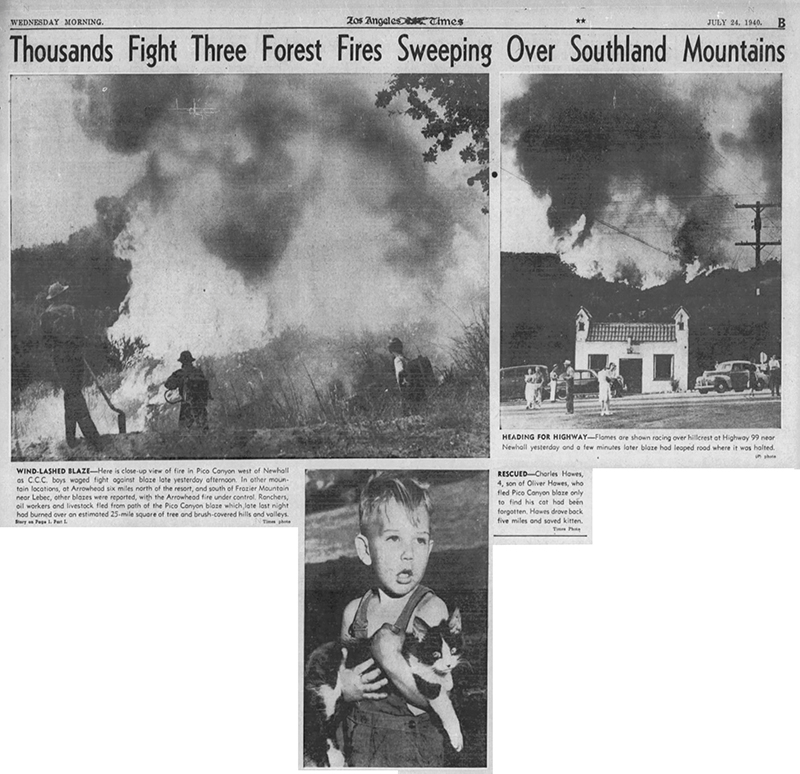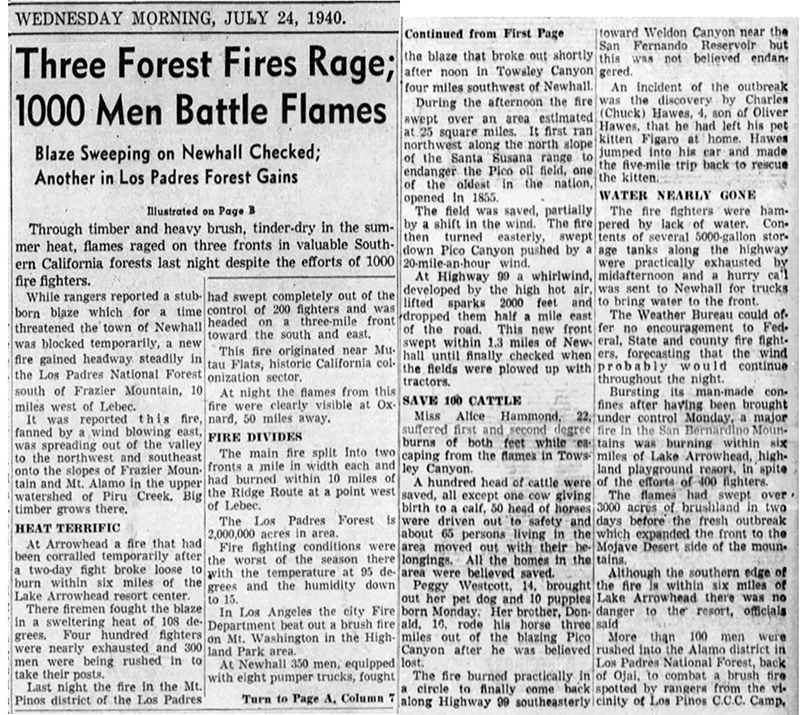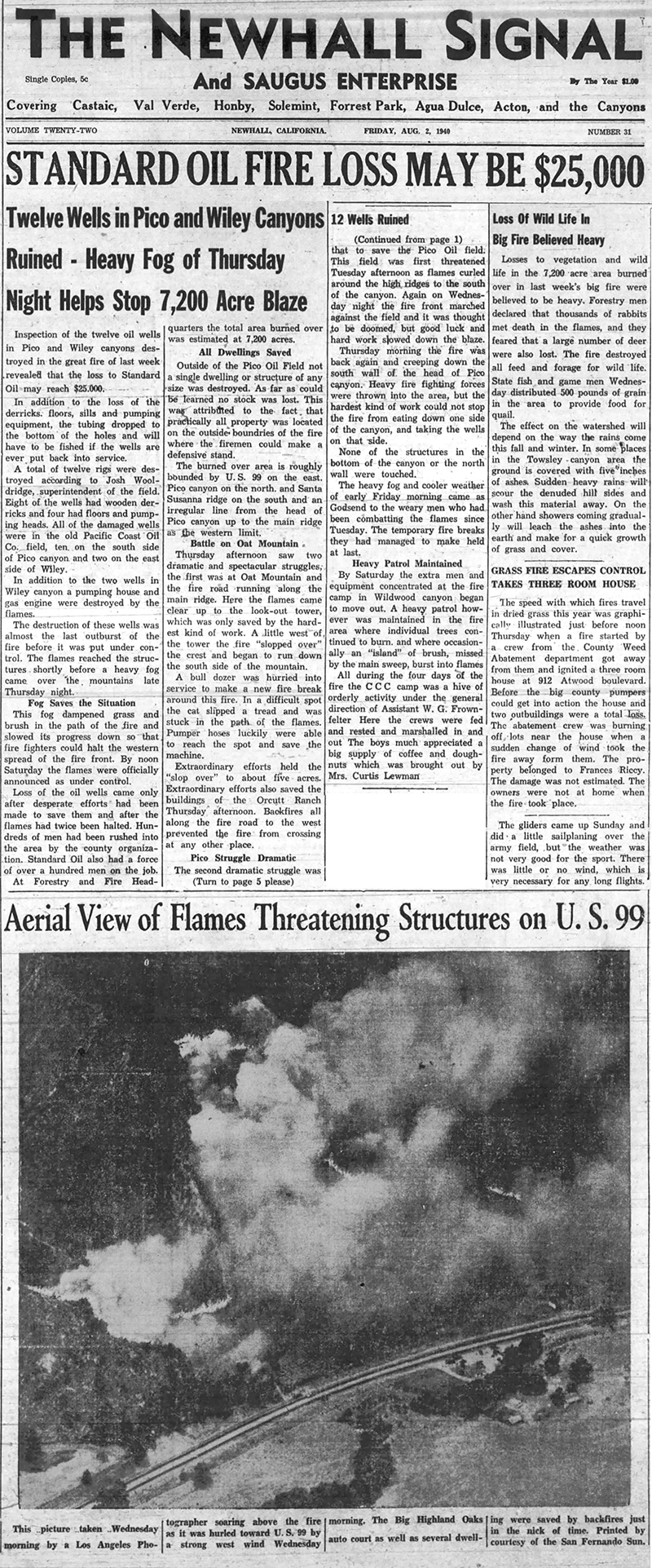Flames Not Yet Under Control
Hill Section Blasted But Heroic Work By 700 Fire Fighters Protect Property — Pico Oil Field Escapes
The Newhall Signal and Saugus Enterprise | Friday, July 26, 1940.

Click to enlarge.
|
At 2 P.M. Thursday a brief communique from the battle front on Oat Mountain stated that the Orcutt Ranch buildings were believed to be safe.
Exhausted fire fighters were striving desperately to control a blaze which jumped the fire break near the lookout station.
A stiff south wind caused the fire to break into a critical threat about noon Thursday on the Oat Mountain front.
The report from Pico canyon stated that the situation was not threatening there.
Thursday morning the situation looked favorable, but a high wind changed the picture at noon. The great fire was in no respect under control.
It had been confined to a quadrangle bounded on the east by U.S. 99 on the North by Pico canyon, on the west by a line running from the Standard Oil field up to the Santa Susanna Ridge, and on the south by the fire road along the top of the Santa Susanna divide east and west from Oat mountain.
Approximately twelve sections or 8,000 acres were burned over.
The property loss was amazingly small.
No lives were lost, nor serious injuries reported.
There was very little loss, if any, of livestock, although a complete check-up was still to be made.
Determined stands made by a force of 700 firefighters, working in relays day and night halted the sweeping blaze.
The Pico canyon road, U.S. 99, and the fire road on the ridge were the lines on which the flames were halted.
Temporary ditches had stopped the western spread of the fire.
Two hundred men with bull dozers were making a new fire break between the head of Pico canyon and the Santa Susanna Ridge.
Within the above named limits the fires had practically burned out. People were moving back into their homes.
The Pico Oil Field was thought to be safe.
The fire was said to be the worst threat to Newhall since 1914. It raged in an area so rough and precipitous that men could not get in to fight it.
The most serious threat to Newhall came on the afternoon of Tuesday when a strong west wind carried the fire across 99 into the hilly section north of Pico road. From here the fire ran across the wide flats clear to the next ridge on the north. Heroic work kept this fire from coming any further east.
The exact manner of origin of the fire had not been determined by forestry and firemen. According to Mrs. Amy Hawes it began in oil-soaked weeds next to the oil well, but how was unexplained. Fire headquarters was notified at 12:10 Tuesday.
Within ten minutes a tower of smoke shot upward out of Towsley canyon as the fire raced through the tinder-like brush. The Hawes family ran for their lives.
Strong south wind drove the flames on an ever-widening front to the north. So rapid was their progress that fire fighters could nowhere make a stand, and it was seen that first line of defense was the road in Pico canyon. Apparatus and men were moved in.
At two o'clock the fire made its appearance in a deep gully just east of Dewitt canyon.
Like a huge blow torch it blasted out of this gully and across the Pico road, going into the ragged hills to the north of the road. Firemen could do nothing to halt the flames and retreated eastward.
About three o'clock Tuesday the wind began to shift into the west. Wheeling in this direction the fire front began to race eastward to ward Highway 99.
In about two hours it had come within a few hundred yards of the main highway and residents of the Pico crossing prepared to move out. These included the Galbraith Service Station, the Loma Verde Cafe, the Williams residence and the LaCanada Pottery and the Self Help dairy.
About four o'clock occurred what was perhaps the most spectacular event of the whole fire.
As the flames neared the highway a natural bowl in the hills set up a whirlwind or chimney blast. Like a giant vacuum cleaner the spinning blast gathered up fire, trash and burning brush, tore limbs off of big oak trees and shot a spectacular column of smoke, dust fire and debris hundreds of feet in the air.
Leaping across the Pico road this fiery whirlwind got into the brush along U.S. 99, and then with a terrific jump, leaped 100 feet across U.S. 99 and started a blaze in the brush of the hills to the north of Pico on the Newhall side of the highway.
The situation was now critical. Backfiring drove the fire front back from the Loma Verde cafe. A defensive front was established in the flats north of Pico and east of 99. For a time this fire threatened all of the property around Pico and U.S. 99.
The wind now shifted again into the north. Tractors and plows were used to throw a barrier in the fields at the margin of the brush.
This fire was the only one which got east of 99. It finally burned itself out without property damage.
In the meantime, the north wind had revived the fire in Towsley and started it scaling the heights toward the Orcutt Ranch and the lookout station on Oat mountain.
The fire fighting forces were rushed up on the main Santa Susanna Ridge, while other parties went into the Lyon Ranch, a battle began to keep the fire from taking the buildings fronting U.S. 99.
By hard work the Lyon ranch buildings were saved. Back firing kept the fire well back from the highway.
As darkness fell the fighters high on the ridge started backfires to protect the south front on Oat Mountain.
These fires made a lurid spectacle as they burned on the high ridges all through Tuesday night.
Wednesday morning the strong south wind sprang up again. The fire again advanced toward U.S. 99. Fighters were massed along the highway. The brush back of the Highland Oaks auto camp was backfired. Because of the trickiness of the wind, small fires started in one or two spots east of the highway but were quickly extinguished. These backfires saved the Highland court and two or three houses fronting 99.
All through Tuesday the flames had been eating their way west on the ridges between Pico canyon and the Santa Susanna divide. In Pico canyon the fire had been halted on the east well of Dewitt canyon. The oil rig there was saved.
But higher up and to the south the fire crept west toward the Standard lease. About three o'clock Wednesday the flames made their appearance on the mountainside south of the Standard lease and were seen to be threatening the Larinan ranch.
Backfires Save Pico Wells
At five o'clock Wednesday a backfire was started in the brush on the south wall of Pico canyon. This measure saved the houses at old Mentryville, the Wescott and Larinan ranches.
Again at nightfall Wednesday the wind pulled around to the north. The fire front reversed and raced toward the Santa Susanna divide. Fighters massed on the ridge west of Oat mountain halted the rush by backfires about ten o'clock Wednesday night.
The only open front for the fire was now on the west. Into this section poured the fire fighters Wednesday night and Thursday morning. The threat to the Pico oil wells had been eliminated by hard work and some good luck. To reinforce this line a new fire break was established.
To combat the fire forces were mobilized from all over the country. The Castaic, Tuna canyon and Angeles CCC camps sent men. Lads from the juvenile camps at Chatsworth, Malibu and Arroyo Seco were drafted. Men and apparatus were rushed from other County Forestry divisions. The U.S. Ranger organization cooperated. The Los Angeles Fire Department sent two pumpers and two bull dozers. Help came from San Fernando. Eleven extra Sheriff deputies and the communications unit helped control crowds. The C.H.P. massed men on the highways. Temporary hospital stations were set up at U.S. 99 and Pico.
No serious injuries were reported although several reported burns, and minor casualties among the fire fighters were numerous.
When the fire was threatening along U.S. 99 traffic was shunted through Newhall. The Pico canyon road was closed for most of the three days.
Fire headquarters, busy with the battle had not made a check-up of property losses. One of the old oil wells in Towsley was burned. The old Stevens property was said to have burned. The Hawes dwelling in Towsley was thought to be burned. A herd of 50 burros was reported missing. Damage to fences and phone lines was heavy. The utilities companies reported no losses.
| 





